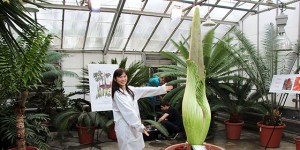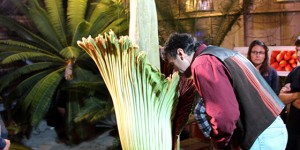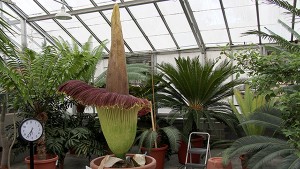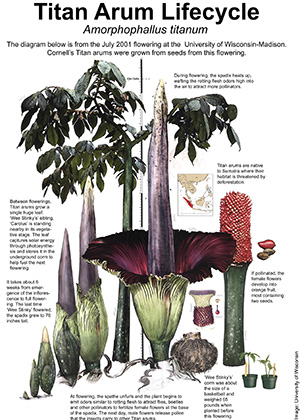
Amorphophallus titanum (Titan arum, corpse plant) is native to the rainforests of Sumatra, Indonesia, where its habitat is threatened by deforestation. It has the largest unbranched flowering structure (inflorescence) of any plant. In cultivation, it generally takes 7-10 years for the first bloom.
What looks like a giant flower, green on the outside and deep red-purple on the inside, is actually a modified leaf, called a spathe. The column-like structure in the middle of the plant is the spadix. Groups of small male and female flowers are located at the base of the spadix, hidden by the spathe surrounding it. It takes about six weeks from the time the inflorescence first emerges until full flowering.
What’s that smell?

When the flowers are ready for pollination, the spadix emits a powerful odor which smells like rotting flesh. Simultaneously the Titan arum generates heat, which helps to diffuse the odor, moving it upward and advertising the bloom to pollinators far and wide, such as carrion flies and beetles.
The female flowers open first, and are only able to be pollinated for one day. The male flowers open on day two and provide viable pollen also only for about one day. Titan arums cannot self-pollinate, so they rely on carrion flies and other insects to carry pollen from one plant to another. If pollination is successful, orange-red fruits develop. In the wild, these are eaten by giant Hornbill birds, which help to disperse the seeds.
Typically, after two days, the spathe will begin to wilt and the spadix to collapse. Sometime after all remnants of the flowering structure and fruits are gone the plant sends up a single, tree-sized compound leaf. This vegetative stage is followed by a 3-7 months long dormant stage. The plant may cycle through several vegetative stages before another flower bud emerges.
Cornell’s Titan Arum Story

In spring of 2012 one of Cornell’s two mature Titan arums—named ‘Wee Stinky’ by popular vote—famously bloomed for the first time. Approximately 10,000 people came to visit the plant in person, while more than 500,000 visitors checked in on its progress via webcam. Then, just two and a half years later, Wee Stinky shifted to a flowering state again and bloomed for a second time.

In June 2015, Wee Stinky’s sibling Carolus was the second Titan arum in Cornell’s Liberty Hyde Bailey Conservatory Collection to bloom. Its large tuber-like corm pushed up an inflorescence bigger than previous blooms at Cornell.
Now, in fall 2016, Wee Stinky is flowering for the third time. Its corm weighed 65 pounds when it was potted in summer, promising another spectacular flowering. Carolus, now in its vegetative state with a massive leaf shaped like small tree, is also on display at the Liberty Hyde Bailey Conservatory.
Both Titan arums were grown at Cornell from tiny seedlings supplied by the University of Wisconsin-Madison in 2001 and provided with daily care by greenhouse growers from the Cornell University Agricultural Experiment Station.
The Conservatory houses one of several plant collections that make up the Liberty Hyde Bailey Hortorium in the Plant Biology Section of the School of Integrative Plant Science (SIPS). The blooms offer researchers and students at SIPS a rare opportunity to study the complex pollination biology of this plant.


